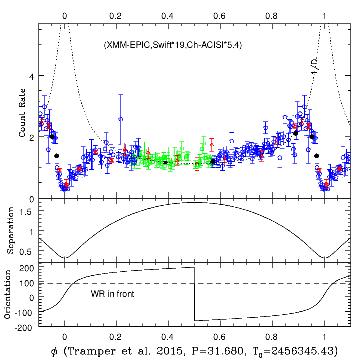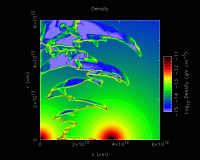- Home
- Research
- Massive Stars
- Wind Collisions
- High Energies
- Interstellar Medium
- Staff
- Outreach
- el TIGRE
Institut d'Astroph. et de Géoph.
Université de Liège
Quartier Agora
Allée du 6 août, 19c - Bât. B5c
B-4000 Liège (Sart-Tilman)
Belgium
Tel.: +32 (0)4.366.97.16
Fax: +32 (0)4.366.97.46
Collisions between stellar winds
Each member of a binary system has its stellar wind. Between the two objects, the two supersonic fluxes of ionized matter rush towards each other at speeds up to several million kilometers per hour: a collision is unavoidable. This collision between the winds impacts all the electromagnetic spectrum. For instance, in the X-ray domain, some binaries exhibit an X-ray emission which is larger than the simple addition of the two individual emissions: the excess is due to the ultra-hot gaz which is born in the head-on shock between the winds. Once the gaz is cooled down, additional emissions become detectable, for instance in the optical domain.

Besides an excess emission, the presence of a wind collision can become noticeable through recurrent variations occurring with the orbital period. Such variations are due to geometrical effects (orientation of the shock zone with respect to the line of sight), to modifications of the strength of the shock due to a variable separation of the stars (in eccentric binaries e.g.), as well as to variations of the circumstellar opacity along the line of sight through the stellar winds (the collision then plays the role of a "mobile sensor"). The GAPHE has specialized in the observations of such variations, both in the optical domain and in that of high energies. We thus follow/monitor the emission of several binary systems (e.g. HD93403, HD152248, WR20a, Cyg OB 2 # 8A, WR21a, 9Sgr) in order to characterize the shock zone as well as the winds involved in the collision. The emission associated to the collision and its variations indeed lead to precious information (and independently from other methods!) on the composition of the winds involved, their speed and their mass-loss rate. GAPHE also develops tomography techniques derived from medical imagery which are useful to constrain the morphology of the shock zones
The hydrodynamic shock can also act as an acceleration site for the atomic particles, thus generating a non-negligible population of relativistic electrons which are at the origin of a non-thermal radiation mechanism. In this domain, GAPHE plays an important role in characterizing the binary systems involved and in searching for the high energy component of such a type of emission [see also this page for further information].
In this framework, an additional technique used by GAPHE is that of interferometry, in particular using VLTI. One uses inferferometric observations in order to detect companions in objects exhibiting signs of wind collisions (particularly non thermal emission) and also to characterize, in the infrared, the formation of dust in the outer zones of the wind collision(s).

Finally, GAPHE also makes use of hydrodynamical models of wind collisions in order to constrain further the information gathered via multi-wavelength observations. Spectra observed at different orbital phases are compared to synthetic spectra generated from a grid of collision winds hydrodynamical models. This type of method has been applied to the binaries WR22, HD152248 and HD159176.



